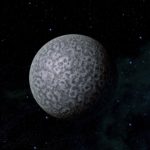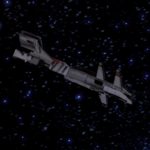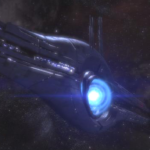System Specs:
- Stellar Mass: 0.4 Sol Masses
- Stellar Class: M V
- Luminosity: N/A Sol
- Planets: 4
- Moons: 1
- Asteroid Belts: 1
- Asteroids: 0
- Objects: 2

Prerequisite: Collector Ship (mission) or Project Firewalker: Rosalie Lost (Mass Effect 2)
Prerequisite: Priority: Rannoch or Citadel: Leviathan I (Mass Effect 3)
Balor is a gateway system. Its star is a red dwarf and its solar output is normally weak; however, during solar flares, its luminosity can double or triple.
The system’s worlds are rich in resources. Mining corporations have only begun to exploit this; some regions are still unexplored and some are beyond economically feasible extraction methods.
–
Planets Directory:
- Cernunnos (Caleston)
- fuel depot
- asteroid belt
- Bres
- Elatha
- Partholon
- Mass Relay
–
Cernunnos:

- Orbital Distance: 0.07 AU
- Orbital Period: 31 Earth-years
- Keplerian Ratio: N/A
- Radius: 49,231 km
- Day Length: 17 Earth-hours
- Atmospheric Pressure: 0.86 atm
- Surface Temp: N/A °C
- Surface Gravity: N/A g
- Mass: N/A Earth-masses
- Satellites: >1
Cernunnos is a sizable gas giant with a hydrogen-nitrogen atmosphere. It is believed to be an extrasolar capture due to its close stellar location. In a rare phenomenon, it is near enough to its red dwarf star to be within the life zone, though its massive size prevents the tidal lock that usually occurs at such a range. While nothing could survive on the surface of a planet with such crushing gravity, Cernunnos’ moon Caleston is habitable. Cernunnos is skimmed for its abundant hydrogen, and refineries on Caleston process it into a metastable metallic form for use as starship fuel.
Mass Effect 3
Cernunnos is a sizable gas giant with high nitrogen content. It is believed to be an extrasolar capture due to its close stellar location. In a rare phenomenon, it is near enough to its red dwarf star to be within the life zone, although its massive size prevents the tidal lock that usually occurs at this range.
While nothing could survive on the surface of a planet with such crushing gravity, Cernunnos’ moon, Caleston, has life. Cernunnos was skimmed for its abundant hydrogen, and refineries on Caleston processed it into a metastable metallic form for use as starship fuel. The Reapers have since destroyed this operation.
–
Caleston:

- Orbital Distance: 0.07 AU (around Cernunnos)
- Orbital Period: 21.5 Earth-hours (around Cernunnos)
- Keplerian Ratio: N/A
- Radius: 6,600 km
- Day Length: 21.5 Earth-hours
- Atmospheric Pressure: 0.9 atm
- Surface Temp: 30 °C
- Surface Gravity: 1.2 g
- Mass: 1.275 Earth-masses
- Colony: Syneu (capital), founded 1975, population 1,802,705,000
The hostile moon Caleston is the largest satellite of the gas giant Cernunnos. An ancient asteroid strike deposited major lodes of element zero within the molten sulfur mantle. Eldfell-Ashland Energy’s (EAE) mining operations have made it the largest source of starship drive core material in the Attican Traverse.
Caleston is wracked with volcanism due to tidal stresses from Cernunnos. Because of weak solar output, plant-like life on Caleston is not carbon-based and photosynthetic but silicon-based and thermo-synthetic, requiring heat rather than sunlight to power its chemical reactions. These organisms flourish in volcanic vents and during solar flares, when Balor can double or triple in luminosity. Sadly, sapient habitation is not possible here, and Caleston’s biodiversity is considered “threatened” by the Citadel Council Committee on Habitable Worlds.
Mass Effect 3
Caleston is the largest satellite of the gas giant Cernunnos. Ancient asteroid strikes deposited major lodes of element zero within the molten sulfur mantle. Eldfell-Ashland Energy’s mining operations made it the largest source of starship drive core material in the Attican Traverse, which threatened Caleston’s native biodiversity with industrial waste.
Caleston is wracked with volcanism due to tidal stresses from Cernunnos. Because of weak solar output, plant-like life on Caleston is not carbon-based and photosynthetic, but silicon-based and thermo-synthetic, requiring heat rather than sunlight to power chemical reactions. These organisms flourish in volcanic vents and during solar flares, when Balor, Caleston’s [sic] sun, can double or triple in luminosity. Oxygen-breathing habitation is not possible outside its many domed cities. Those cities are now feasts for the Reapers, who drove off Caleston’s protective fleet and now threaten to puncture domes to force the population into submission.
–
Bres:

- Orbital Distance: 2.9 AU
- Orbital Period: 4.9 Earth-years
- Keplerian Ratio: 1.016
- Radius: 975 km
- Day Length: 23.3 Earth-hours
- Atmospheric Pressure: 0.00 atm
- Surface Temp: −146 °C
- Surface Gravity: 0.173 g
- Mass: 0.004 Earth-masses
A member of the Fomor Belt, Bres is a dwarf planet with no atmosphere. It is, however, rich in lithium, which is integral to the heat sinks of starships and hand-held weapons. A large robo-mining operation from Caleston can be found here.
Mass Effect 3
A member of the Fomor Belt, Bres is a dwarf planet with no atmosphere. It is, however, rich in lithium, which is integral to the heat sinks of many starships and handheld weapons. A large robo-mining operation from Caleston once existed here, but the miners quickly abandoned the area when they learned they were in the path of the Reapers.
–
Elatha:

- Orbital Distance: 5.5 AU
- Orbital Period: 23.6 Earth-years
- Keplerian Ratio: 0.299
- Radius: 1,812 km
- Day Length: 57.3 Earth-hours
- Atmospheric Pressure: 43.34 atm
- Surface Temp: −72 °C
- Surface Gravity: 0.1 g
- Mass: 0.008 Earth-masses
A tiny rock planet, Elatha is noted for its frigid temperatures and crushing nitrogen and krypton atmosphere. Lying out beyond the Fomor Belt, there is little to recommend it.
–
Partholon:

- Orbital Distance: 11.2 AU
- Orbital Period: 68.6 Earth-years
- Keplerian Ratio: 0.299
- Radius: 11,921 km
- Day Length: 28.2 Earth-hours
- Atmospheric Pressure: Trace atm
- Surface Temp: −236 °C
- Surface Gravity: 6.6 g
- Mass: 22.885 Earth-masses
A large planet composed of ice surrounding a rocky core, Partholon retains trace gases of nitrogen and carbon monoxide. Its crushing gravity makes for an inhospitable stay and makes most mining infeasible. However, its orbit’s proximity to the mass relay in the system means space travelers will, for the next few years, use it for a gravitational slingshot to add speed on their way to and from Caleston.
–
–
video








